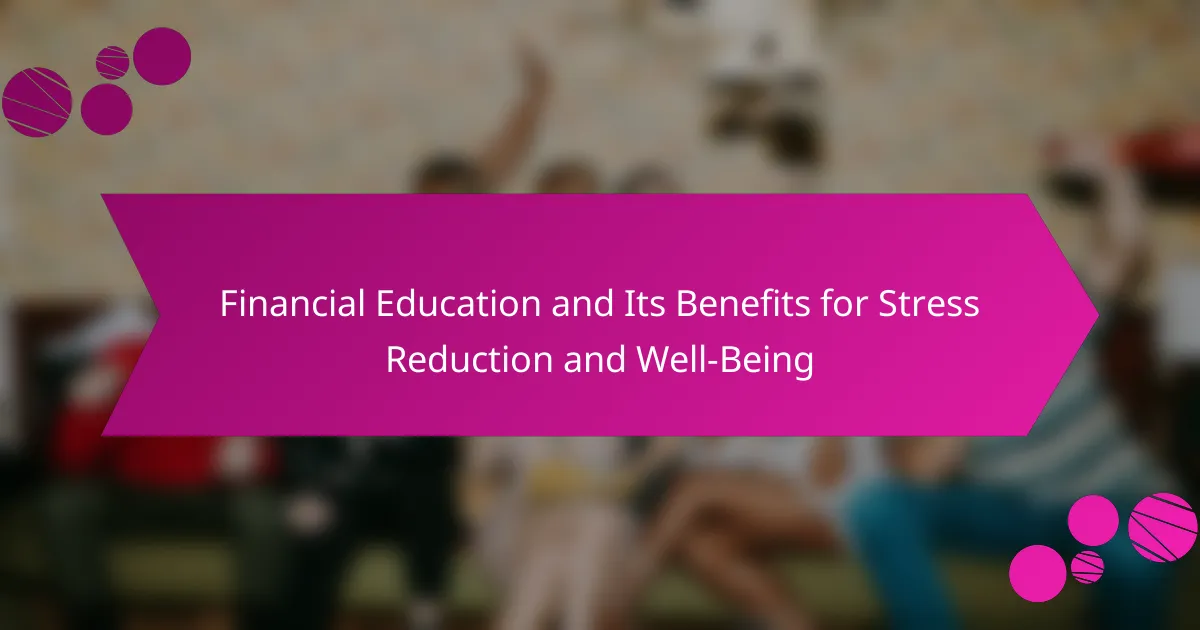Financial literacy programs significantly improve financial decision-making and reduce stress, enhancing urban living and mental health. Participants gain essential skills in budgeting, saving, and investing, leading to greater financial stability. These programs foster community engagement and support networks, contributing to economic resilience. Successful initiatives incorporate interactive methods and real-life applications to address unique local challenges.

How do financial literacy programs impact urban living?
Financial literacy programs significantly enhance urban living by improving financial decision-making and reducing stress. Participants often report increased confidence in managing budgets and savings. This empowerment contributes to better mental health outcomes, as individuals feel more in control of their financial situations. Studies show that communities with robust financial literacy initiatives experience lower rates of poverty and crime, fostering a more stable urban environment.
What are the key components of effective financial literacy programs?
Effective financial literacy programs incorporate essential components that enhance urban living and mental health. Key components include curriculum design, accessibility, community engagement, and ongoing support.
Curriculum design focuses on practical skills such as budgeting, saving, and investing. Accessibility ensures programs reach diverse populations, including marginalised groups. Community engagement fosters collaboration with local organisations to create relevant content. Ongoing support provides resources and mentorship to reinforce learning.
These attributes collectively contribute to improved financial decision-making, reducing stress and enhancing overall well-being in urban environments.
How do these programs enhance mental health in urban populations?
Financial literacy programs significantly enhance mental health in urban populations by reducing financial stress and increasing confidence. Participants gain essential budgeting skills, which lead to improved financial decision-making. This empowerment fosters a sense of control, reducing anxiety associated with economic instability. Studies show that individuals with better financial literacy report higher overall well-being and lower levels of depression. Additionally, community engagement through these programs strengthens social networks, providing emotional support that further enhances mental health outcomes.
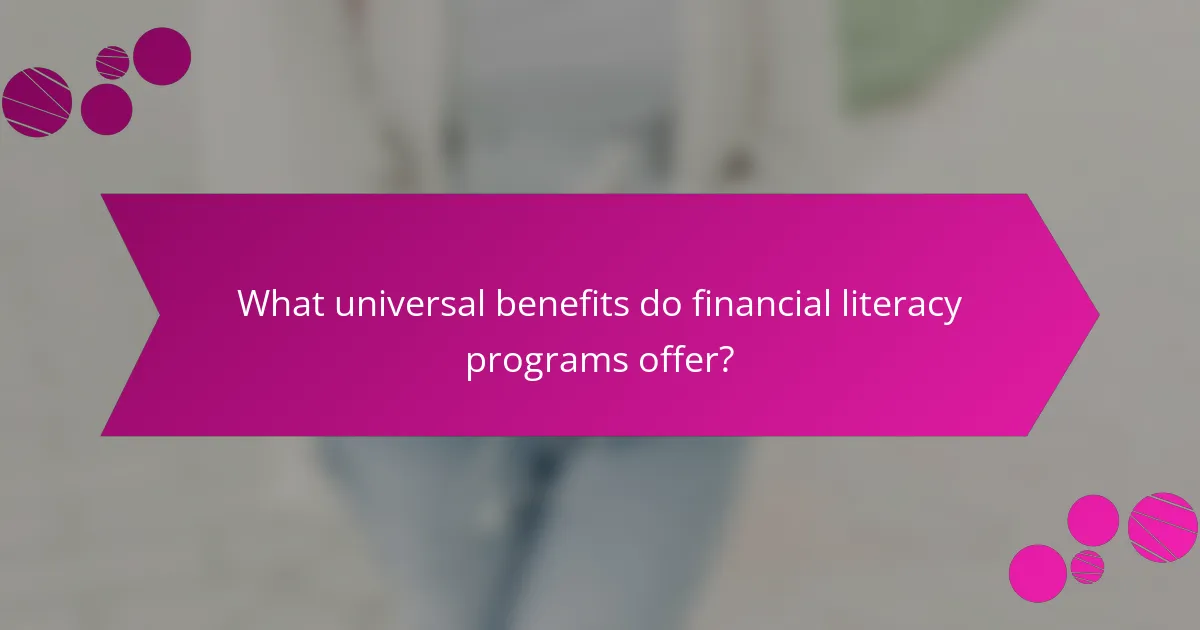
What universal benefits do financial literacy programs offer?
Financial literacy programs offer numerous universal benefits that enhance urban living and improve mental health. They empower individuals with essential financial skills, fostering confidence and reducing anxiety related to money management.
Participants learn budgeting, saving, and investment strategies, which contribute to financial stability. This stability can lead to improved mental well-being, as individuals feel more secure and less stressed about their financial situations.
Moreover, these programs often promote community engagement, creating networks of support among participants. As a result, financial literacy programs can transform urban environments by enhancing economic resilience and social cohesion.
How do these programs improve financial decision-making skills?
Financial literacy programs enhance financial decision-making skills by providing participants with essential knowledge and practical tools. These programs teach budgeting, savings strategies, and investment principles, empowering individuals to manage their finances effectively. As a result, participants often report increased confidence in making informed financial choices, leading to improved economic stability. Studies show that individuals who engage in financial literacy programs demonstrate better credit scores and lower debt levels, highlighting the tangible benefits of such education.
What role do financial literacy programs play in reducing stress?
Financial literacy programs significantly reduce stress by equipping individuals with essential money management skills. Improved financial knowledge leads to better budgeting, saving, and investment decisions, which directly alleviate financial anxiety. Studies show that participants in these programs report lower stress levels and increased confidence in handling financial challenges. By fostering a sense of control over finances, these programs contribute to enhanced mental well-being and urban living quality.
What specific financial skills are taught?
Financial literacy programs teach essential financial skills such as budgeting, saving, investing, and debt management. Participants learn to create budgets that track income and expenses, develop savings strategies for emergencies, and understand investment options to grow wealth. Additionally, they gain insights into managing and reducing debt effectively. These skills enhance urban living and promote mental health by reducing financial stress.
How do financial literacy programs foster community engagement?
Financial literacy programs enhance community engagement by providing knowledge and skills that empower individuals. These programs foster collaboration, build trust, and create networks among participants. As a result, communities experience improved financial decision-making, leading to increased economic stability. Engaged individuals are more likely to participate in local initiatives, contributing to a vibrant community culture.
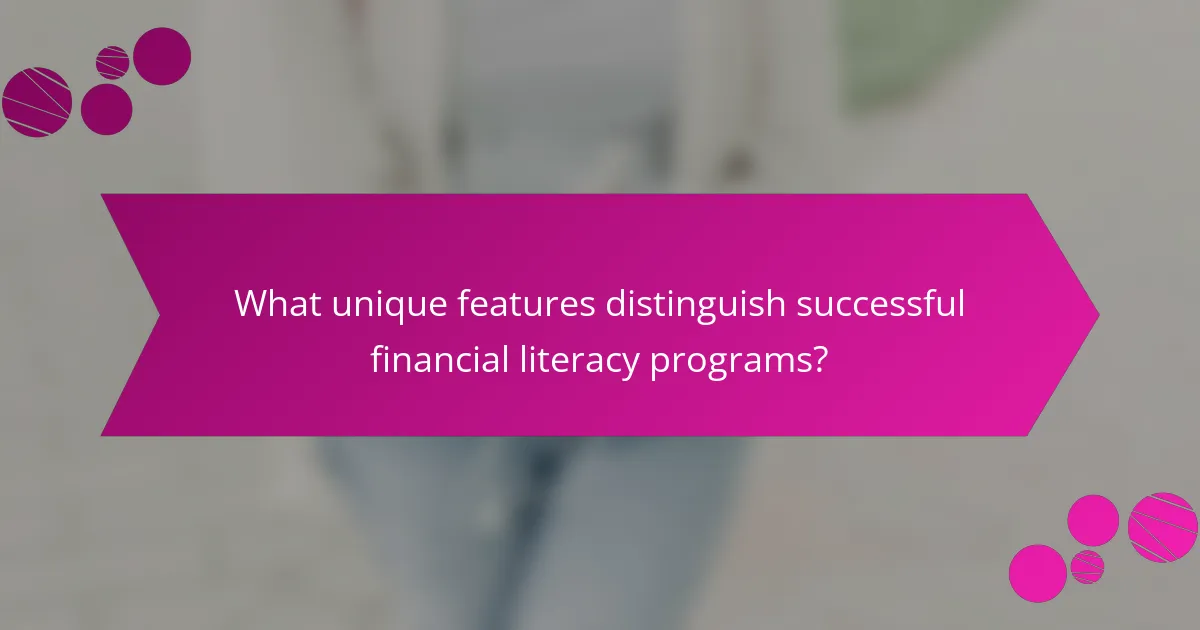
What unique features distinguish successful financial literacy programs?
Successful financial literacy programs are distinguished by their interactive approaches, community involvement, and tailored content. These programs often incorporate gamification, making learning engaging and effective. They also prioritise accessibility, ensuring resources are available in multiple formats. Additionally, successful programs frequently include follow-up support, enabling participants to apply their knowledge practically. Data shows that programs emphasising real-life applications achieve higher retention rates.
How do tailored programs address specific community needs?
Tailored financial literacy programs effectively meet specific community needs by addressing unique economic challenges. These programs adapt content to reflect local financial realities, enhancing urban living and mental health. For instance, they may focus on budgeting skills, debt management, or investment strategies. Such targeted approaches empower individuals, leading to improved financial stability and reduced stress. As a result, communities experience a boost in overall well-being and resilience.
What innovative teaching methods are used in these programs?
Innovative teaching methods in financial literacy programs include experiential learning, gamification, and community engagement. Experiential learning allows participants to apply concepts in real-life scenarios, enhancing retention. Gamification introduces competitive elements, making learning engaging and motivating. Community engagement fosters collaboration and support, creating a network for shared knowledge and resources. These methods address unique attributes of urban living, promoting mental health through financial empowerment.
How do partnerships with local organizations enhance program effectiveness?
Partnerships with local organisations significantly enhance the effectiveness of financial literacy programs. These collaborations leverage community insights and resources, fostering tailored approaches that resonate with urban populations. Local organisations often possess unique attributes, such as established trust within the community, which can increase program participation and engagement. As a result, these partnerships can lead to improved financial behaviours and mental health outcomes among participants.
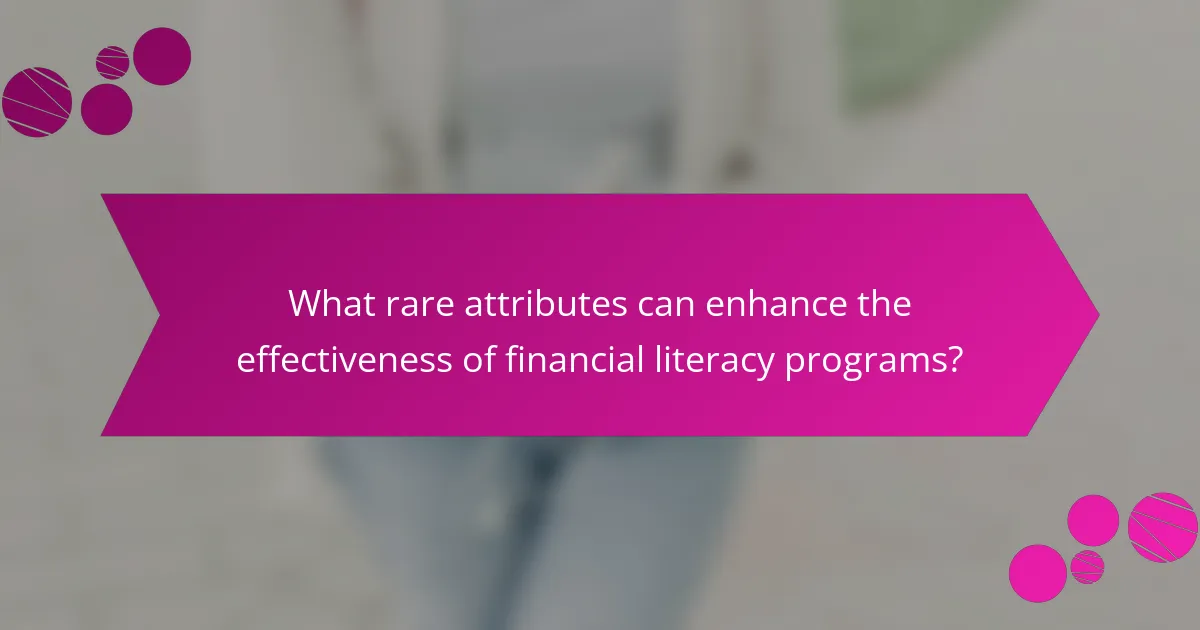
What rare attributes can enhance the effectiveness of financial literacy programs?
Tailoring financial literacy programs with rare attributes can significantly enhance their effectiveness. Integrating community-specific financial challenges, such as local economic conditions, can foster relevance. Additionally, incorporating culturally relevant content addresses unique demographic needs, improving engagement. Utilizing technology, like gamified learning tools, offers interactive experiences that resonate with younger audiences. Lastly, personalised mentorship can provide rare one-on-one guidance, fostering deeper understanding and application of financial concepts.
How do cultural considerations shape program content?
Cultural considerations significantly shape financial literacy programs by tailoring content to diverse community needs. Programs must reflect local values, languages, and economic realities to enhance engagement and effectiveness. For instance, culturally relevant examples can improve understanding, while community partnerships foster trust. Additionally, recognising unique financial challenges faced by specific groups can lead to more impactful learning experiences.
What are some uncommon success stories from specific programs?
Financial literacy programs have led to unique success stories that highlight their impact on urban living and mental health. One notable example is a program in Detroit that integrated financial education with mental health support, resulting in a 30% increase in participants’ financial stability and a significant reduction in anxiety levels. Another success story comes from a Chicago initiative that partnered with local businesses, providing job training alongside financial literacy. This dual approach resulted in a 40% employment rate among graduates, demonstrating the program’s effectiveness. Additionally, a program in Los Angeles focused on immigrant communities, offering culturally tailored financial workshops. Participants reported increased confidence in managing their finances, leading to improved overall well-being. These uncommon successes illustrate the transformative potential of financial literacy programs in urban settings.
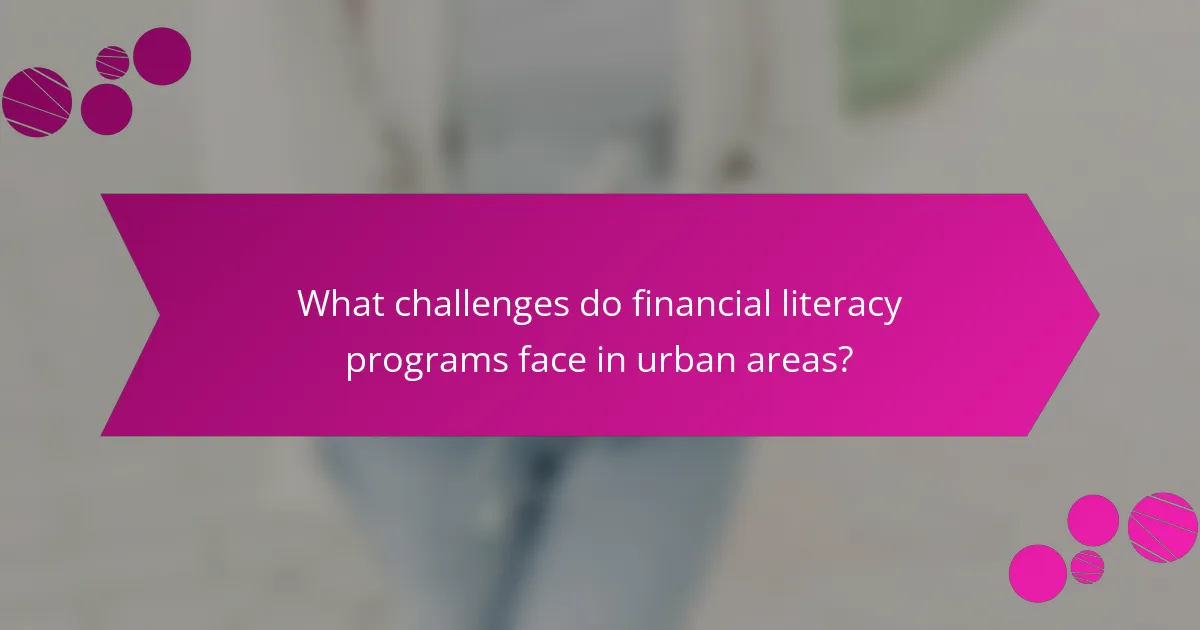
What challenges do financial literacy programs face in urban areas?
Financial literacy programs in urban areas face challenges such as accessibility, cultural barriers, and resource limitations. Many residents lack access to quality financial education due to economic constraints. Additionally, cultural differences can hinder engagement and understanding of financial concepts. Programs often struggle with insufficient funding and trained personnel, limiting their outreach and effectiveness. As a result, these factors contribute to lower participation rates and reduced impact on improving financial literacy.
How can programs overcome barriers to participation?
Financial literacy programs can overcome barriers to participation by implementing targeted outreach strategies. These strategies include partnering with community organisations to reach underserved populations and providing incentives such as free resources or meals. Additionally, addressing unique barriers like transportation and scheduling through flexible program timings can significantly enhance engagement. Programs that incorporate culturally relevant materials and language support further improve accessibility, ensuring diverse community members feel included.
What are common misconceptions about financial literacy programs?
Many believe financial literacy programs only focus on budgeting and saving, but they encompass broader skills like investment and risk management. Misconceptions include the idea that these programs are only for low-income individuals, while they benefit all socioeconomic groups. Additionally, some think that financial literacy can be achieved in a single workshop, overlooking the need for ongoing education and practice. Finally, there is a belief that financial literacy guarantees financial success, which fails to account for external factors like economic conditions.
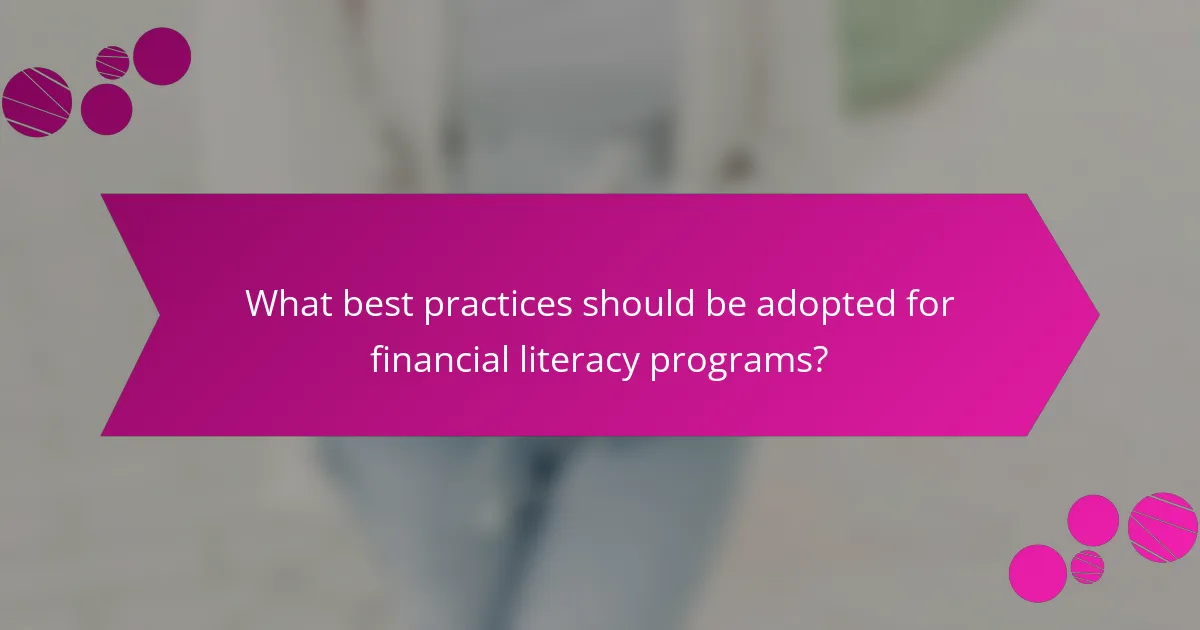
What best practices should be adopted for financial literacy programs?
To enhance financial literacy programs, adopt interactive methods, provide real-life applications, and ensure continuous evaluation. Engaging participants through workshops and discussions fosters better understanding. Incorporating practical scenarios helps connect theory to daily financial decisions. Regular assessments allow for program adjustments, ensuring relevance and effectiveness.
How can participants maximize the benefits of these programs?
Participants can maximize the benefits of financial literacy programs by actively engaging, applying learned skills, and seeking support. Regular attendance enhances understanding of concepts like budgeting and saving. Practicing these skills in real-life situations solidifies knowledge. Forming study groups or networks fosters collaboration and accountability. Utilizing available resources, such as online tools or community workshops, further enriches the learning experience.
What are the common pitfalls to avoid in program implementation?
Common pitfalls in program implementation include insufficient needs assessment, lack of stakeholder engagement, inadequate training, and failure to measure outcomes. These issues can hinder the effectiveness of financial literacy programs aimed at enhancing urban living and mental health. For example, neglecting to involve community members may result in a program that does not address their specific financial challenges. Additionally, without proper training for facilitators, the delivery of content may be inconsistent, reducing participant engagement. Lastly, failing to evaluate program success limits the ability to make necessary adjustments, ultimately impacting the program’s overall effectiveness.
What expert insights can inform future program development?
Expert insights suggest that integrating financial literacy into urban living initiatives significantly enhances mental health outcomes. Programs should focus on practical skills, such as budgeting and saving, which empower individuals and reduce stress. Data indicates that participants in financial literacy programs report a 30% increase in financial confidence, leading to improved well-being. Collaborations with local organisations can provide tailored resources that address unique community needs, fostering a supportive environment for learning. Continuous evaluation of program effectiveness is essential to adapt strategies and maximize impact.

